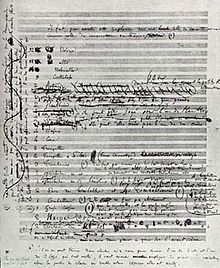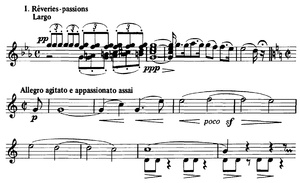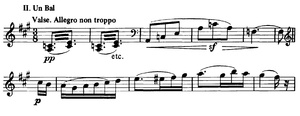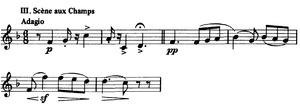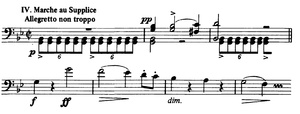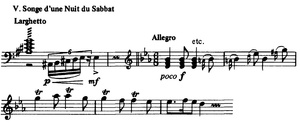Symphonie fantastique
The Fantastic Symphony op.14 , in the original episode de la vie d'un artiste, symphonie fantastique en cinq parties ( episode from the life of an artist, fantastic symphony in five parts ), is a programmatic musical work by Hector Berlioz . With this work, Berlioz founded program music and created one of the most important pieces of romantic music .
The work, dedicated to Tsar Nicholas I of Russia , premiered on December 5, 1830 under the direction of François-Antoine habeneck at the Paris Conservatory . Lélio ou Le retour à la vie (op. 14b), a “Monodrame lyrique” (1831–1832 / 1855), written in Italy, can be seen as a continuation of the Symphonie fantastique .
With the Symphonie fantastique , composed in 1830, Berlioz broke new ground, although he followed on from Beethoven's 6th Symphony (1808). The piece also includes some (at that time) completely new instrumentation techniques (such as the wide-ranging divisi playing of the strings) and the resulting novel and innovative use of the classical orchestral body. Berlioz also explicitly called his work a drame musical (" musical drama ") and consequently divides it into five movements analogous to the five acts of the classical drama . The leitmotif (idée fixe), the motif of the “beloved”, is processed in the sentences that are assigned to the individual scenes.
Sentences and program
- Dreams, Passions (Rêveries, Passions), Largo (C minor, 4/4 time) - Allegro agitato e appassionato assai (C major, 2/2 time); Duration: approx. 15 min
- A young musician meets a woman who fully corresponds to his ideal. In the artist's soul it always appears in connection with a musical thought (the leitmotif, idée fixe). At the beginning, the lover longs for his lover (slow introduction, thematically independent). In the Allegro part, the beloved is introduced radiantly (monothematic sonata main movement form ). Different moods of being in love are experienced.
- A ball (Un Bal), Allegro non troppo, (A major, 3/8 time); Duration: approx. 6 min
- The lover finds the woman again at a ball. In the music, the idée fixe is embedded in a waltz. At first he is happy to see each other again, but soon realizes that his lover doesn't seem to pay any attention to him. The brilliant dance music, however, continues undisturbed.
- Scene in the Country (Scène aux champs), Adagio (F major, 6/8 time); Duration: approx. 16 min
- The movement begins with a dialogue between the cor anglais and the oboe as two shepherds talking. Then there is a sudden interruption for the idée fixe, the beloved appears again. The lover gets painful doubts as to whether she is loyal to him. One of the shepherds picks up the starting melody, the other no longer answers. Sunset, warning rumble of thunder (represented by the cluster chords of four timpani ), loneliness, silence.
- The walk to the place of execution (Marche au supplice), Allegretto non troppo (G minor, 2/2 time); Duration: approx. 7 min
- After knowing that his love will be spurned, he takes opium and falls into a deep, death-like sleep. He dreams that he has murdered his lover, that he is doomed to death and that he is being led to the place of execution. A march, now dark and wild, then again brilliant and solemn, accompanies the train. The idée fixe is only quoted shortly before the execution by the guillotine.
- Witches' Sabbath (Songe d'une nuit du Sabbat), Larghetto (C minor, 4/4 time) - Allegro (E flat major, later C major, 6/8 time); Duration: approx. 10 min
- The lover finds himself on a witch's sabbath, piercing laughter can be clearly heard. Suddenly the idée fixe is reproduced several times in a very distorted, mean variation, first by the high-pitched Eb clarinet, then the orchestra joins in: The former lover appears as a witch and is greeted happily by the other witches. Then the death bells ring and introduce a parody of the Dies irae , the Last Judgment from the Catholic funeral mass. Finally, both melodies mix into one hell of a orgy.
The use of the idée fixe, which Carl Maria von Weber had previously practiced in his operas, had a great influence on the music of the Romantic period, especially on Franz Liszt and Richard Wagner . Franz Liszt made a piano transcription of the work.
Emergence
On September 11, 1827, Berlioz had attended a production of Shakespeare's Hamlet and fell in love with Ophelia, the Irish actress Harriet Smithson . He sent her countless love letters, none of which she answered. When she left Paris she still hadn't responded. Instead, he wrote his "lovesickness" from his soul through the "Symphonie fantastique".
The first performance of the symphony took place in Paris on December 5, 1830. She heard the work two years later and finally recognized the genius of the composer. The two met and married on October 3, 1833. However, their marriage became increasingly problematic and they eventually separated after several unhappy years of marriage.
Instrumentation
What was new was the drama, which was intensified by expanded orchestration. The orchestral line-up of the work looks as follows:
- 2 flutes (2nd also piccolo )
- 2 oboes (2nd also English horn )
- 2 clarinets in C, A, Bb and Eb
- 4 bassoons
- 4 horns in C, Eb, E, F and B deep
- 2 cornets in A and B
- 2 trumpets in Bb and C
- 3 trumpets
- 1 ophicleide , 1 serpent is added in the fifth movement (in some later editions 2 tubes)
- 2 harps
- Timpani (up to 4 players required)
- Bass drum , cymbals , snare drum , 2 bells in C and G
- Strings in the usual line-up (1st and 2nd violins , violas , cellos , double basses ), 1st and 2nd violins, however, each partially divided into three parts, violas, cellos and double basses each divided into two parts
The sometimes extremely wide-ranging division or the divisi play of the strings was completely new at the time of the composition and is more reminiscent of much later sound borrowings from Richard Strauss or Erich Wolfgang Korngold. Harps and piccolo were also not part of a common orchestral line-up at that time. The large bassoons and timpani are also striking. In addition, the cornets catch the eye, which even today are rarely used in symphonic literature and are more at home in brass music .
literature
- Robert Schumann : Symphony by H. Berlioz (1835).
- Rudolf Kloiber : Handbook of Symphonic Poetry. (1967), 3rd edition. Breitkopf & Härtel, Wiesbaden 1990, ISBN 3-7651-0018-8 .
- Wolfgang Dömling : The Symphonie fantastique and Berlioz 'conception of program music , in: Die Musikforschung 28 (1975), pp. 260–283
- Christian Berger: Fantastic as a construction. Hector Berlioz '' Symphonie fantastique ' (= Kieler Schriften zur Musikwissenschaft 27), Kassel: Bärenreiter 1983, ISBN 3-7618-0726-0
- Wolfgang Dömling: Symphonie fantastique. In: Wulf Konold (Ed.): Lexicon Orchestermusik Romantik A – H. Schott, Mainz 1989, ISBN 3-7957-8226-0 , pp. 22-27.
Web links
- Symphonie Fantastique : Sheet music and audio files in the International Music Score Library Project
- Program text (German)
Individual evidence
- ^ Wolfgang Dömling: Berlioz . Rowohlt, Reinbek bei Hamburg, 5th edition 2001, pp. 50 and 133.
- ↑ Mémoires de Hector Berlioz (French)
- ↑ In the performance instructions of the autograph, Berlioz writes: "If a church serpent plays improperly, as is usually the case, an ophicleide does better service" Cf. p. XXXIV in the foreword to: Symphonie Fantastique , edited by Nicholas Temperly, Kassel u. a .: Bärenreiter 1972 (Hector Berlioz. New Edition of the Complete Works Volume 16).
